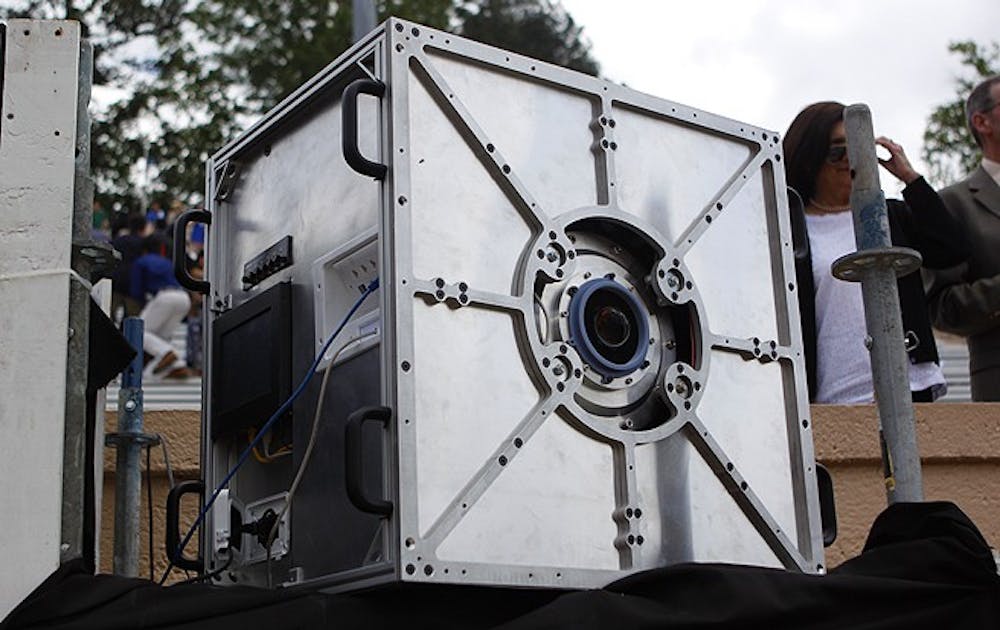Supercameras created by engineers in the Pratt School of Engineering are in the process of being made available to the public.
The gigapixel cameras can take much larger, higher resolution and more interactive images than cameras currently publicly available. Aqueti, a Durham based start-up, was created as a spin-off of the University’s research and design project with the purpose of releasing the technology into the market. The cameras were created by the AWARE program-—a collaboration between Duke University, the University of Arizona and Distant Focus Corporation.
“It’s going to change the way we think of images so far,” AWARE Project Manager Steve Feller said. “With this, you can zoom in and out so much. There’s a lot more information, a lot more ways to experience the images. It’s going to change the way people interact with images into something that you explore and play with.”
A standard DSLR camera is 25 megapixels, but the gigapixel cameras designed by AWARE take images of 250 and 750 megapixels, Feller said. Of the gigapixel cameras AWARE plans to release, these cameras are the lowest resolution: a medium resolution camera is expected to be completed next month, and a high resolution camera, eight times more powerful than the current baseline model, will be out by early 2014.
Two of the AWARE cameras were used to take images at this year’s commencement ceremony, and one of over 400 images is available online.
“A normal camera is a very narrow image, so we replicate that, but over the whole field,” said Patrick Llull, a second year Pratt graduate student who designed and optimized the algorithm that allows the cameras to focus in images. “It’s like taking a single camera and taking 36 pictures and putting them together—instead of scanning and stitching them, we’re taking just one picture at the same time.”
An AWARE camera costs about $100,000, but cameras used at events like commencement cost $350,000 and are not gigapixel cameras, making the AWARE camera competitive in the market, said Aqueti Vice President Scott McCain, who received his Ph.D. in 2007 from Pratt. Although defense contractors have already produced gigapixel cameras, they are much larger than the AWARE cameras and cost millions of dollars.
Aqueti has been in talks with undisclosed major media companies and is in the process of getting business contracts lined up, McCain said. A plausible business model is to use advertising revenue to make the technology sustainable.
Broadcast networks, such as ESPN and FOX, are the types of customers that would be interested in the cameras, Feller said.
Carolina Zoomin’ is another effort to make the technology available to the public. If the project is able to raise $25,000 on Kickstarter by June 19, Aqueti will go on a road trip with the gigapixel cameras, visiting places that Kickstarter pledgers suggest in North Carolina and taking images that will be available on the Internet. To date, there are 20 backers who have pledged $957.
“People are really interested, but they haven’t bought as much stuff as we wanted,” McCain said. “But we’ve still got some time to get the message out there.”
The road trip would focus on visiting sites such as a boat race or the mountains of North Carolina, where there is normally little commercial incentive due to the small audience and high costs of the cameras.
“Basically as we wind down the government side of this program, we’re spinning off a commercial side,” Feller said. “The idea with the Kickstarter is it’s a way for us to do something that normally wouldn’t make financial sense.”
Future models of the cameras will still produce high-resolution images, but will be much smaller cameras due to improved optical and electronics design, Feller said. There are also plans to eventually use the technology to produce gigapixel videos, he added.
One of the big applications of the technology is an interactive television where viewers can zoom in an out of different parts of a video stream, McCain said.
“When you’re at home watching the game on your TV, phone, iPad, you don’t have to just see what the broadcasters are sending you,” he said. “You could be moving the camera with your fingers to see what the coaches are doing or you could zoom in on the players or out to see the whole field, and thousands of people could be doing this all at once.”
Get The Chronicle straight to your inbox
Signup for our weekly newsletter. Cancel at any time.

